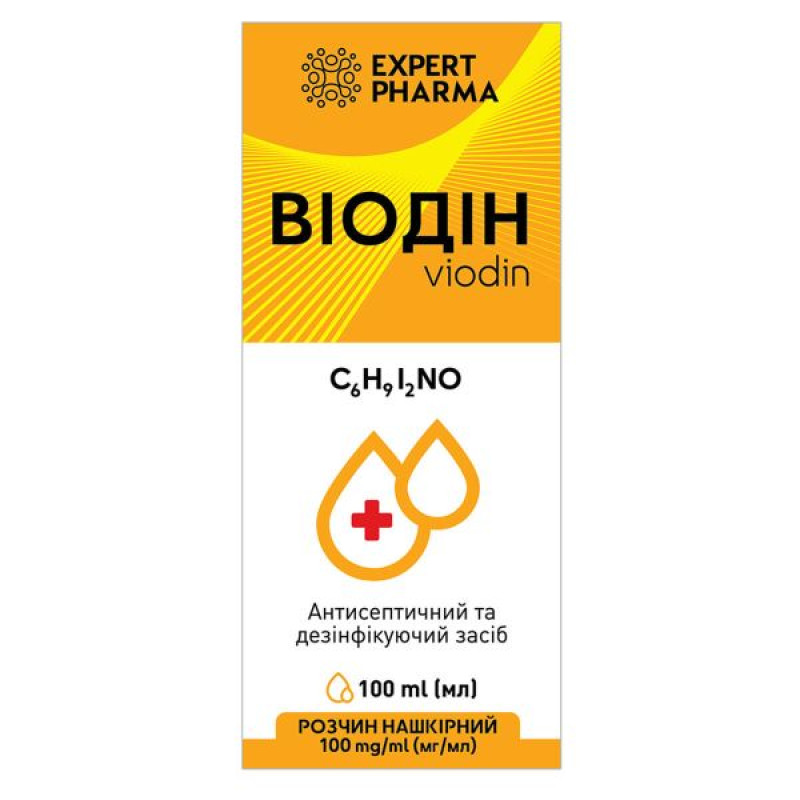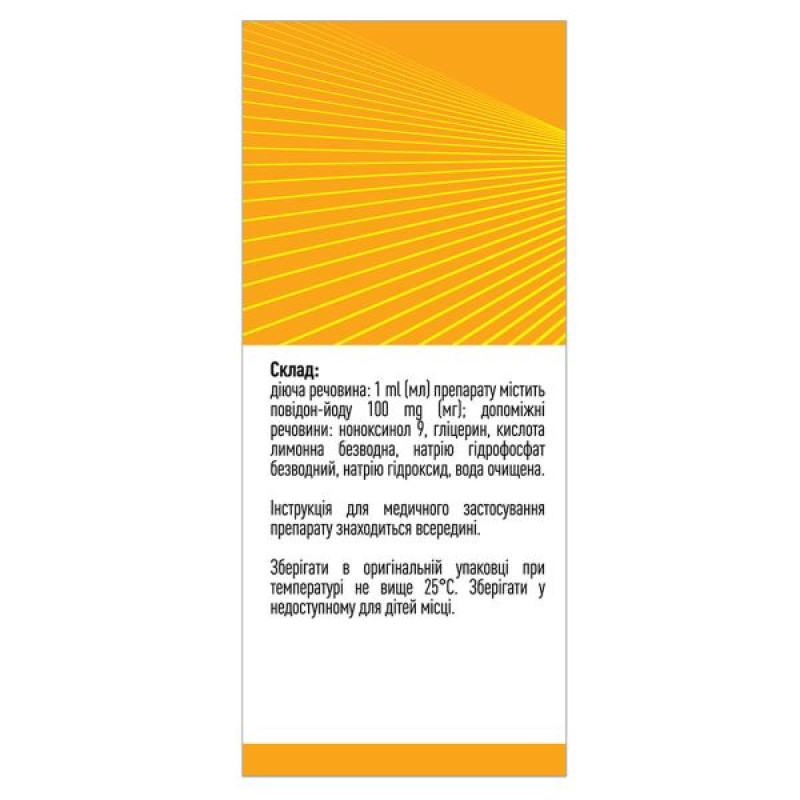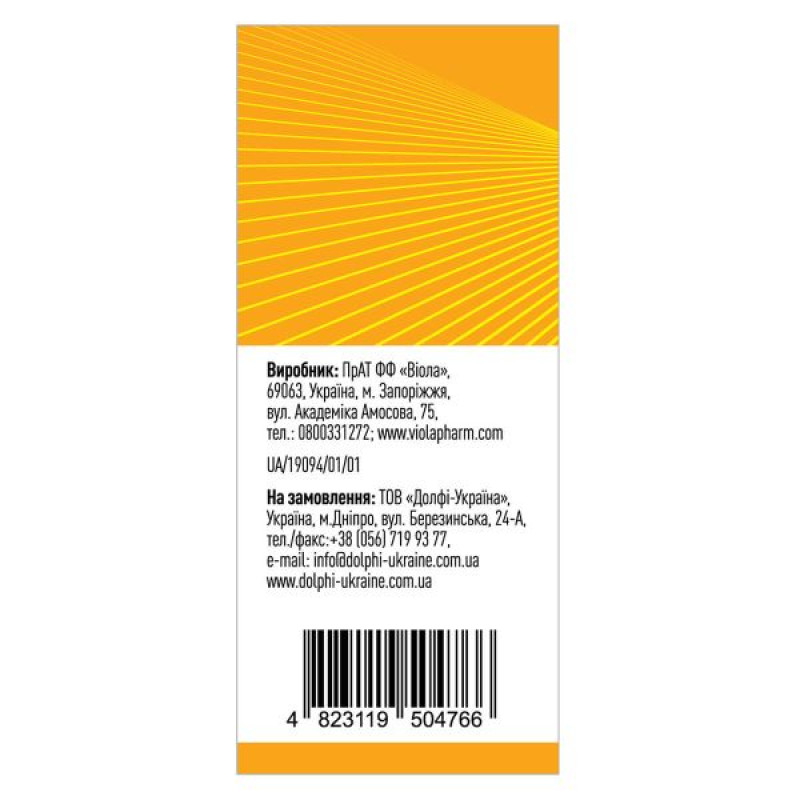Viodin cutaneous solution 100 mg/ml Expert Pharma bottle 100 ml

Instructions Viodin cutaneous solution 100 mg/ml Expert Pharma bottle 100 ml
Composition
active ingredient: povidone-iodine;
1 ml of the drug contains povidone-iodine 100 mg;
excipients: nonoxynol 9, glycerin, citric acid anhydrous, sodium hydrogen phosphate anhydrous, sodium hydroxide, purified water.
Dosage form
Transdermal solution 100 mg/ml.
Main physicochemical properties: dark brown solution with an iodine odor, free from suspended and precipitated particles.
Pharmacotherapeutic group
Antiseptics and disinfectants. Povidone-iodine.
ATX code D08A G02.
Pharmacological properties
Pharmacodynamics.
Povidone-iodine is a complex of iodine and the polymer polyvinylpyrrolidone (PVP), which releases iodine over a period of time after application to the skin. Elemental iodine has a strong bactericidal effect, has a broad spectrum of antimicrobial activity against bacteria, viruses, fungi and protozoa.
Mechanism of action: free iodine exhibits a rapid bactericidal effect, and the polymer is a depot for iodine.
Upon contact with skin and mucous membranes, a significant amount of iodine is released from the polymer.
When forming a complex with PVP, iodine largely loses the local irritant effect inherent in alcoholic solutions of iodine, therefore it is well tolerated by the skin, mucous membranes, and affected surfaces.
Iodine reacts with oxidizing sulfide (SH–) and hydroxyl (OH–) groups of amino acids that are part of enzymes and structural proteins of microorganisms, inactivating or destroying these proteins. Most microorganisms are destroyed by in vitro action in less than a minute, and the main destructive effect occurs in the first 15-30 seconds. In this case, iodine is discolored, and therefore a change in the saturation of the brown color is an indicator of its effectiveness.
The active ingredient of the drug VIODIN, a cutaneous solution, has a broad antimicrobial spectrum of action: it acts on gram-positive and gram-negative bacteria (bactericidal), on viruses (virulicidal), on fungi (fungicidal) and fungal spores (sporicidal), as well as on some protozoan microorganisms (antiprotozoal).
Due to the mechanism of action, resistance to the drug, including secondary resistance with long-term use, is not expected.
The drug dissolves in water and is easily washed off with water.
Pharmacokinetics.
Prolonged application of the drug to large wound surfaces or severe burns, as well as mucous membranes, can lead to the absorption of a significant amount of iodine. Usually, as a result of long-term use of the drug, the iodine content in the blood increases rapidly. The concentration returns to the initial level 7-14 days after the last use of the drug.
In patients with normal thyroid function, increasing iodine stores does not cause clinically significant changes in thyroid hormonal status.
The absorption and renal excretion of povidone-iodine depends on its molecular weight, and since it varies between 35,000-50,000, retention of the substance is possible.
The volume of distribution corresponds to approximately 38% of body weight, the biological half-life after vaginal administration is approximately 2 days. The normal total plasma iodine level is approximately 3.8-6 μg/dl, and the inorganic iodine level is 0.01-0.5 μg/dl.
The drug is excreted from the body mainly by the kidneys with a clearance of 15 to 60 ml/min depending on the level of iodine in the blood plasma and creatinine clearance (normal: 100-300 mcg of iodine per 1 g of creatinine).
Indication
Hand disinfection and antiseptic treatment of mucous membranes, for example, before surgical operations, gynecological and obstetric procedures, bladder catheterization, biopsy, injections, punctures, blood sampling, as well as as first aid for accidental contamination of the skin with infected material.
Antiseptic treatment of wounds and burns.
Hygienic and surgical hand disinfection.
Contraindication
Hypersensitivity to iodine or suspected hypersensitivity to other components of the drug.
Thyroid dysfunction (nodular colloid goiter, endemic goiter and Hashimoto's thyroiditis).
The drug is contraindicated before and after treatment and radioactive iodine scintigraphy in patients with thyroid carcinoma.
During's dermatitis herpetiformis.
Kidney failure.
Interaction with other medicinal products and other types of interactions
The use of povidone-iodine simultaneously with or immediately after use with antiseptics containing octenidine may lead to the appearance of dark necrosis at the application sites.
Povidone-iodine should not be used simultaneously with disinfectants containing chlorhexidine, hydrogen peroxide, taurolidine, silver sulfadiazine, mercury and alkalis, due to a possible partial decrease in the activity of the drug.
Simultaneous topical application of povidone-iodine and benzoin tincture results in a decrease in pH, which may cause a burning sensation, especially if the wound is bandaged.
Concomitant use of povidone-iodine and lithium preparations may cause a synergistic hypothyroid effect.
Application features
The use of povidone-iodine may reduce the uptake of iodine by the thyroid gland, which may affect the results of some examinations and procedures (thyroid scintigraphy, determination of protein-bound iodine, diagnostic procedures using radioactive iodine), and therefore planning the treatment of thyroid disease with iodine preparations may be impossible. After stopping treatment with povidone-iodine, a break of at least 1-4 weeks is required.
The oxidizing effect of povidone-iodine may lead to false-positive results in diagnostic tests (e.g., toluidine and guaiac tests for hemoglobin and glucose in feces and urine).
The oxidizing action of povidone-iodine may cause corrosion of metals, while plastic and synthetic materials are generally not sensitive to povidone-iodine. In isolated cases, discoloration may occur, which is usually reversible.
Povidone-iodine is easily removed from textiles and other materials with warm soapy water. Stains that are difficult to remove should be treated with ammonia solution or sodium thiosulfate.
The solution is not intended for internal use.
During preoperative skin disinfection, care should be taken to ensure that no solution remains under the patient (due to the possibility of skin irritation).
Since the development of hyperthyroidism cannot be excluded, long-term (more than 14 days) use of povidone-iodine or its use in significant quantities on large surfaces (more than 10% of the body surface) in patients (especially the elderly) with latent thyroid dysfunction should be considered only after careful assessment of the expected benefit and possible risk. Such patients should be monitored for early signs of hyperthyroidism and appropriate thyroid function testing should be performed, even after discontinuation of the drug (up to 3 months).
Discoloration of the solution indicates a decrease in the effectiveness of the drug. Light and temperatures above 40 ° C accelerate the decomposition of the active substance of the drug. The solution is intended for external use only.
Use during pregnancy or breastfeeding
Povidone-iodine is not teratogenic. The drug is contraindicated for use after the 2nd month of pregnancy and during breastfeeding. Iodine crosses the placental barrier and may enter breast milk. Breastfeeding should be discontinued during treatment.
Ability to influence reaction speed when driving vehicles or other mechanisms
Unknown.
Method of administration and doses
The drug is intended for external use in diluted and undiluted form. The drug should not be mixed with hot water. Only short-term heating to body temperature is permissible.
Dosage
An undiluted solution of VIODIN is used to treat hands and skin before surgery, bladder catheterization, injections, and punctures.
The solution can be used 2-3 times a day.
Hygienic hand disinfection: 2 times 3 ml of undiluted solution, each dose of 3 ml remains on the skin for 30 seconds.
Surgical hand disinfection: 2 times 5 ml of undiluted solution, each dose of 5 ml remains on the skin for 5 minutes.
To disinfect the skin, the undiluted solution is left to dry after application.
According to the above indications, the solution can be used after dilution with tap water. During operations, as well as for antiseptic treatment of wounds and burns, 0.9% sodium chloride solution or Ringer's solution should be used for dilution.
The following dilutions are recommended:
| Indication | Dilution | Volume of drug/volume of solvent |
| Wet compress | 1:5-1:10 | 200 ml–100 ml/1 l |
| Immersion and sitz baths | 1:25 | 40 ml/1 l |
| Preoperative bath | 1:100 | 10 ml/1 l |
| Hygienic bath | 1:1000 | 10 ml/10 l |
Vaginal douching Insertion of an intrauterine device Perineal irrigation Irrigation in urology | 1:25 | 4 ml/100 ml |
| Irrigation of chronic and postoperative wounds | 1:2-1:20 | 50 ml–5 ml/100 ml |
Irrigation in orthopedics and traumatology Irrigation during oral surgery | 1:10 | 10 ml/100 ml |
The solution should be diluted immediately before use.
Children.
In newborns and children under 1 year of age, povidone-iodine should be used only if absolutely necessary. If necessary, thyroid function should be monitored.
Overdose
The following symptoms are characteristic of acute iodine intoxication:
– metallic taste in the mouth, increased salivation, heartburn or pain in the mouth or throat;
– irritation and swelling in the eyes;
– skin reactions;
– gastrointestinal disorders and diarrhea;
– renal dysfunction and anuria;
– circulatory failure;
– laryngeal edema with secondary asphyxia, pulmonary edema, metabolic acidosis, hypernatremia.
Long-term treatment of burn wounds with significant amounts of povidone-iodine may cause electrolyte imbalance or serum osmolarity with impaired renal function or metabolic acidosis.
Treatment: symptomatic and supportive therapy should be administered with special attention to electrolyte balance, renal function and thyroid function.
In case of intoxication caused by accidental oral administration of the drug, immediate administration of food containing starch or protein (such as starch solution in water or milk), gastric lavage with 5% sodium thiosulfate solution, and if necessary, intravenous administration of 10 ml of 10% sodium thiosulfate solution at 3-hour intervals is indicated. Monitoring of thyroid function is indicated for early detection of iodine-induced hyperthyroidism.
Adverse reactions
Investigations: changes in serum electrolyte levels (hypernatremia) and osmolarity, metabolic acidosis.
Renal and urinary disorders: renal dysfunction, acute renal failure.
Skin and subcutaneous tissue disorders: local skin hypersensitivity reactions such as contact dermatitis with psoriatic-like red small bullous lesions; allergic reactions including itching, redness, rash, angioedema.
If these signs appear, the use of the drug should be discontinued.
Endocrine system: hyperthyroidism, hypothyroidism. Prolonged use of povidone-iodine may lead to absorption of large amounts of iodine.
In some cases, iodine-induced hyperthyroidism has been observed as a result of prolonged use of the drug, mainly in patients with thyroid disease.
In some cases, generalized acute reactions with a decrease in blood pressure and/or difficulty breathing (anaphylactic reactions) are possible.
Expiration date
2 years.
Storage conditions
Store in the original packaging at a temperature not exceeding 25 °C.
Keep out of reach of children.
Packaging
30 ml in a bottle, 1 bottle, sealed with a pipette cap, in a pack;
100 ml in a bottle, 1 bottle, sealed with a nozzle and cap, in a pack;
1000 ml in a bottle sealed with a cap or dropper and cap.
Vacation category
Without a prescription.
Producer
PrJSC FF "Viola".
Location of the manufacturer and address of its place of business.
Ukraine, 69063, Zaporizhia, 75 Academician Amosov St.
There are no reviews for this product.
There are no reviews for this product, be the first to leave your review.
No questions about this product, be the first and ask your question.












